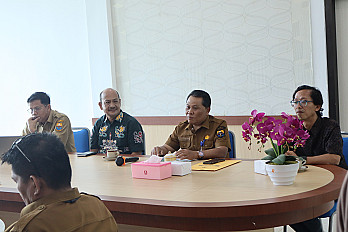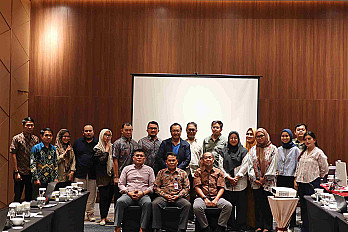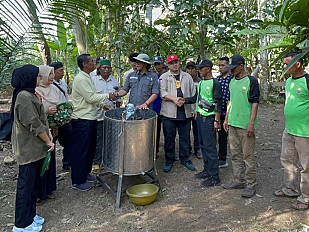News
40
Coordination of the Preparation of the Emission Reduction Monitoring Report (ERMR) Phase I: Strengthening Jambi's Commitment to Sustainable Emission Reduction
-detail.jpg)
Portal BIOCF
Wednesday, 03 September 2025 Post 12:09 AM
Jambi, September 3–4, 2025 — The Jambi Provincial Government, through the Regional Development Planning Agency (Bappeda), held a Coordination Meeting for the Preparation of the Phase I Emission Reduction Monitoring Report (ERMR) for the Jambi Emission Reduction Program (ERP) for the 2020–2022 period. This event served as a crucial opportunity to ensure Jambi Province's readiness to move towards results-based payments (RBP) through a collaborative mechanism with the World Bank.
Opening and Strategic Direction
The meeting was opened by Ir. H. Sepdinal, ME, representing the Head of Bappeda. In his remarks, he emphasized that the preparation of the ERMR is a strategic step in efforts to reduce greenhouse gas emissions in Jambi. The Phase I ERMR includes seven chapters and five appendices prepared by the MAR team with cross-sectoral contributions, including safeguards, monitoring and evaluation (M&E), the Benefit Sharing Mechanism (BSM), and other aspects.
BIOCF Program Progress and Pre-Investment
As of mid-2025, the BioCarbon Fund (BIOCF) program remains in the pre-investment phase, focusing on strengthening institutions and policies. Negotiations on the Emission Reduction Payment Agreement (ERPA) with the World Bank have been delayed due to updates to the environmental, social, and benefit sharing plan (BSP) documents. Despite this, budget realization has reached 77.2%, despite various operational challenges in the field.
Emissions Data Compilation and Consistency
During the discussion of the ERMR document, meeting participants highlighted the importance of data consistency with national sources such as SignSmart and IPSDH. Activity data, particularly from the agriculture and livestock sectors, is expected to be completed by 2024. The technical team emphasized that all land cover change data will be presented in Excel matrix format to facilitate the verification process and avoid data discrepancies.
Benefit Sharing Plan (BSP): Fairness for All Parties
The BSP preparation is now in the finalization stage. The benefit-sharing plan includes 57% based on performance, 1–1.5% for voluntary palm oil companies, and 5% for small-scale social forestry (PS) groups. The discussion also highlighted the determination of the intermediary institution (Lemtara) for benefit distribution, with three options: a local selection team under the Governor, a central agency, or the BPDLH.
The main challenges lie in the completeness of beneficiary data and field validation. To prevent overlap, the BSP recommends using a single safeguard document, which has been approved since 2022.
Safeguards and Integration of Supporting Documents
The Jambi emission reduction program implements two safeguard systems: the OPBP for free investment and the ISS for result-based payment. It was agreed that there was no need to create new documents, but rather to adapt existing guidelines. Synchronization between the BSP and safeguards is a priority to avoid implementation conflicts.
Carbon Trading and National Registration
The discussion also covered the carbon registration process in the National Registration System (SRN) and its integration with the World Bank's Carbon Asset Tracking System (CATS). All entities, including indigenous communities and NGOs like Warsi, are required to register with the SRN and obtain central government approval. The discussion highlighted the importance of regional regulatory readiness for an effective carbon trading mechanism.
Implementation and Coordination Challenges
Several challenges remain, ranging from limited microdata on carbon asset groups, changes in spatial planning policies, to cross-sectoral synchronization. The Jambi Provincial Government is committed to strengthening coordination and accelerating ERPA negotiations to support the sustainability of results-based payments.
Day Two: Deeper Understanding of Reversal Buffers, Safeguards, and Non-Carbon Benefits
Managing Reversal and Buffer Risks
The discussion on Thursday, September 4, 2025, focused on buffer mechanisms and reversal risks, referring to the 2023 SFL Buffer Requirement. Fifteen percent of total emission reductions will be allocated as a buffer account to anticipate the risk of emission reversals due to fires, floods, land tenure conflicts, or renewed deforestation.
Chapter 6 of the ERMR includes a risk assessment, buffer tool, and a narrative linking Annex 1 safeguards and non-carbon benefits (NCBs). Baseline data, actual emissions, and major events such as El Niño, peat fires, or permit conflicts are the main components of the report.
Safeguard Implementation and ESDD
In this session, Mr. Deddy presented the Environmental and Social Due Diligence (ESDD) assessment, which assesses the program's compliance with World Bank safeguard standards for the 2022–2024 period. The ESDD analysis covers environmental risks, working conditions, biodiversity conservation, and indigenous community involvement.
The Head of Safeguards, Linda, added that monitoring is conducted twice a year and will focus more on peatland management to prevent fires and emissions. Meanwhile, Sahru from the safeguards team reported that the ESDD document has been revised and is ready to be submitted to the World Bank.
Technical Discussion and Follow-up
Meeting participants provided various input, including the importance of assessing the impact of production forest utilization permits under 5 hectares, potential conflicts with national strategic projects, and the need to monitor forest rehabilitation and conservation activities.
It was also agreed upon the importance of regular cross-sectoral meetings to expedite the resolution of technical issues and coordination with central ministries.
Data Monitoring and Supporting Technology
The Monitoring and Evaluation (Monev) Team explained the development of an OCM (Online Collaboration Management) portal for real-time data collection by all sectors and beneficiaries. The use of drones by Forest Management Units (KPH) was also proposed to improve the accuracy of rehabilitation area monitoring. All data will be stored for a minimum of seven years, as stipulated in the cooperation agreement with the World Bank.
Social Forestry and Oil Palm Management
The meeting also discussed the incentive mechanism for oil palm owners under the social forestry scheme. KPHs were urged to conduct strict guidance to prevent land use violations after the PS Decree is issued.
The issue of "jangka benah" (long-term improvement) in oil palm plantations received special attention because it requires realistic and equitable solutions on the ground.
Non-Carbon Benefits: More Than Just Emissions
In addition to emission reductions, Jambi also emphasizes non-carbon benefits (NCBs) such as improved local livelihoods, transparent forest governance, and biodiversity conservation. Supporting data for NCBs will be collected by the Monitoring and Evaluation (M&E) team, supported by spatial imagery and field reports to ensure the accuracy of achievement claims.
Closing: Strengthening the Foundation for Results-Based Payments
The two-day coordination meeting resulted in several important agreements, ranging from data consistency to synchronization of ERMR, BSP, and safeguard documents. With cross-sector synergy and support from all stakeholders, Jambi Province affirms its commitment to becoming a model for implementing results-based emission reduction programs in Indonesia.
The agreed-upon steps are expected to form a strong foundation for the sustainability of the BIOCF program and accelerate the achievement of low-carbon development targets in Tanah Sepucuk Jambi Sembilan Lurah.
Opening and Strategic Direction
The meeting was opened by Ir. H. Sepdinal, ME, representing the Head of Bappeda. In his remarks, he emphasized that the preparation of the ERMR is a strategic step in efforts to reduce greenhouse gas emissions in Jambi. The Phase I ERMR includes seven chapters and five appendices prepared by the MAR team with cross-sectoral contributions, including safeguards, monitoring and evaluation (M&E), the Benefit Sharing Mechanism (BSM), and other aspects.
BIOCF Program Progress and Pre-Investment
As of mid-2025, the BioCarbon Fund (BIOCF) program remains in the pre-investment phase, focusing on strengthening institutions and policies. Negotiations on the Emission Reduction Payment Agreement (ERPA) with the World Bank have been delayed due to updates to the environmental, social, and benefit sharing plan (BSP) documents. Despite this, budget realization has reached 77.2%, despite various operational challenges in the field.
Emissions Data Compilation and Consistency
During the discussion of the ERMR document, meeting participants highlighted the importance of data consistency with national sources such as SignSmart and IPSDH. Activity data, particularly from the agriculture and livestock sectors, is expected to be completed by 2024. The technical team emphasized that all land cover change data will be presented in Excel matrix format to facilitate the verification process and avoid data discrepancies.
Benefit Sharing Plan (BSP): Fairness for All Parties
The BSP preparation is now in the finalization stage. The benefit-sharing plan includes 57% based on performance, 1–1.5% for voluntary palm oil companies, and 5% for small-scale social forestry (PS) groups. The discussion also highlighted the determination of the intermediary institution (Lemtara) for benefit distribution, with three options: a local selection team under the Governor, a central agency, or the BPDLH.
The main challenges lie in the completeness of beneficiary data and field validation. To prevent overlap, the BSP recommends using a single safeguard document, which has been approved since 2022.
Safeguards and Integration of Supporting Documents
The Jambi emission reduction program implements two safeguard systems: the OPBP for free investment and the ISS for result-based payment. It was agreed that there was no need to create new documents, but rather to adapt existing guidelines. Synchronization between the BSP and safeguards is a priority to avoid implementation conflicts.
Carbon Trading and National Registration
The discussion also covered the carbon registration process in the National Registration System (SRN) and its integration with the World Bank's Carbon Asset Tracking System (CATS). All entities, including indigenous communities and NGOs like Warsi, are required to register with the SRN and obtain central government approval. The discussion highlighted the importance of regional regulatory readiness for an effective carbon trading mechanism.
Implementation and Coordination Challenges
Several challenges remain, ranging from limited microdata on carbon asset groups, changes in spatial planning policies, to cross-sectoral synchronization. The Jambi Provincial Government is committed to strengthening coordination and accelerating ERPA negotiations to support the sustainability of results-based payments.
Day Two: Deeper Understanding of Reversal Buffers, Safeguards, and Non-Carbon Benefits
Managing Reversal and Buffer Risks
The discussion on Thursday, September 4, 2025, focused on buffer mechanisms and reversal risks, referring to the 2023 SFL Buffer Requirement. Fifteen percent of total emission reductions will be allocated as a buffer account to anticipate the risk of emission reversals due to fires, floods, land tenure conflicts, or renewed deforestation.
Chapter 6 of the ERMR includes a risk assessment, buffer tool, and a narrative linking Annex 1 safeguards and non-carbon benefits (NCBs). Baseline data, actual emissions, and major events such as El Niño, peat fires, or permit conflicts are the main components of the report.
Safeguard Implementation and ESDD
In this session, Mr. Deddy presented the Environmental and Social Due Diligence (ESDD) assessment, which assesses the program's compliance with World Bank safeguard standards for the 2022–2024 period. The ESDD analysis covers environmental risks, working conditions, biodiversity conservation, and indigenous community involvement.
The Head of Safeguards, Linda, added that monitoring is conducted twice a year and will focus more on peatland management to prevent fires and emissions. Meanwhile, Sahru from the safeguards team reported that the ESDD document has been revised and is ready to be submitted to the World Bank.
Technical Discussion and Follow-up
Meeting participants provided various input, including the importance of assessing the impact of production forest utilization permits under 5 hectares, potential conflicts with national strategic projects, and the need to monitor forest rehabilitation and conservation activities.
It was also agreed upon the importance of regular cross-sectoral meetings to expedite the resolution of technical issues and coordination with central ministries.
Data Monitoring and Supporting Technology
The Monitoring and Evaluation (Monev) Team explained the development of an OCM (Online Collaboration Management) portal for real-time data collection by all sectors and beneficiaries. The use of drones by Forest Management Units (KPH) was also proposed to improve the accuracy of rehabilitation area monitoring. All data will be stored for a minimum of seven years, as stipulated in the cooperation agreement with the World Bank.
Social Forestry and Oil Palm Management
The meeting also discussed the incentive mechanism for oil palm owners under the social forestry scheme. KPHs were urged to conduct strict guidance to prevent land use violations after the PS Decree is issued.
The issue of "jangka benah" (long-term improvement) in oil palm plantations received special attention because it requires realistic and equitable solutions on the ground.
Non-Carbon Benefits: More Than Just Emissions
In addition to emission reductions, Jambi also emphasizes non-carbon benefits (NCBs) such as improved local livelihoods, transparent forest governance, and biodiversity conservation. Supporting data for NCBs will be collected by the Monitoring and Evaluation (M&E) team, supported by spatial imagery and field reports to ensure the accuracy of achievement claims.
Closing: Strengthening the Foundation for Results-Based Payments
The two-day coordination meeting resulted in several important agreements, ranging from data consistency to synchronization of ERMR, BSP, and safeguard documents. With cross-sector synergy and support from all stakeholders, Jambi Province affirms its commitment to becoming a model for implementing results-based emission reduction programs in Indonesia.
The agreed-upon steps are expected to form a strong foundation for the sustainability of the BIOCF program and accelerate the achievement of low-carbon development targets in Tanah Sepucuk Jambi Sembilan Lurah.



-thumb.jpg)


-thumb.jpg)
-thumb.jpg)